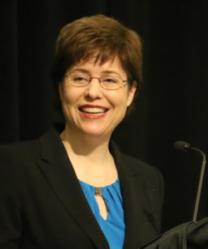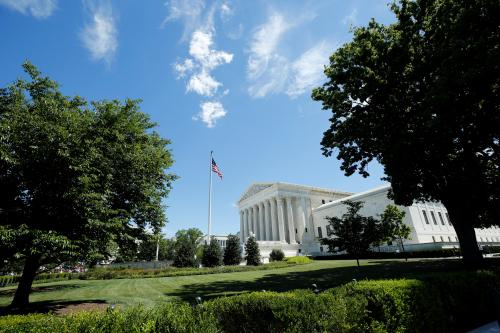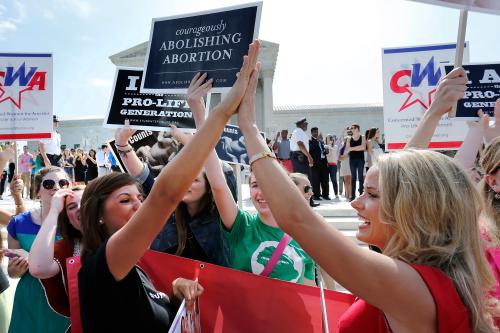Justices John Paul Stevens and Antonin Scalia do not see eye-to-eye on much, but they are in sync when it comes to interpreting the First Amendment’s Free Exercise Clause. As long as the government isn’t seeking to undermine religious practices, it does not matter how much the state burdens them. So, for example, if a public school imposes a “no hat” rule because it wants to prevent students from wearing baseball caps and reads that rule to bar the wearing of yarmulkes as well, there’s no free exercise problem — the school wasn’t targeting religious practices. This is the basic teaching of the Supreme Court’s 1990 watershed opinion in Employment Division v. Smith, which Justice Scalia authored and four other justices, including Justice Stevens, joined.
In the document dumps from the presidential library of Bill Clinton, there’s some suggestion that Elena Kagan thinks about these issues differently. If Kagan is elevated to the Supreme Court, and she does part ways with Justices Scalia and Stevens on these matters, it could mark the first time a critic of the 1990 Smith decision and its weak reading of the Free Exercise Clause replaces a supporter of that decision. This would move the Court closer to reinvigorating the Free Exercise Clause, and thus closer to providing additional protection for the peaceful practice of all faiths.
The Fall of Free Exercise: Employment Division v. Smith
The First Amendment’s Establishment and Free Exercise Clauses set forth special rules the government must follow when it interacts with religion. Nevertheless, in the 1990 Smith decision, the Supreme Court basically reduced the Free Exercise Clause to a constitutional redundancy. It essentially held that this clause simply bars the government from intentionally or overtly discriminating against religious practices, something other constitutional provisions already guarantee.
The Smith decision broke with traditional doctrine that provided a much higher level of protection for religious exercise. It also involved the Court in deciding far more than was necessary to resolve the case. Thus, the decision was immediately greeted with widespread calls for rehearing and reversal, calls the Court rejected.
This prompted a broad coalition of religious and civil liberties groups to work for passage of the Religious Freedom Restoration Act (RFRA), a measure that sought to reinstate traditional free exercise protections through a federal statute. In 1993, Congress passed RFRA with nearly unanimous support, and President Bill Clinton signed it into law.
Under RFRA, the claimant must first show that the government has substantially burdened his or her sincere religious practice. If the claimant is able to do so, then the state must justify the burden with a narrowly tailored compelling state interest. If the government makes such a showing, it wins the case and the substantial burden is deemed to be the unavoidable consequence of a balancing of competing interests. If the government cannot do so, it loses and must lift the burden on religious exercise.
Another Smith Case: Smith v. Fair Employment and Housing Commission
In August 1996, a RFRA case came to Elena Kagan’s attention in her capacity as associate counsel at the Clinton White House. She received a call from Steve McFarland, then with the Christian Legal Society, informing her that the Solicitor General’s office had decided against filing a petition with the United States Supreme Court asking it to hear a case involving a widow, Evelyn Smith, who owned and leased four rental units in Chico, California. Smith had refused to rent to an unmarried couple due to her religious belief that sex outside of marriage is sinful, and that if she rented an apartment to the cohabitating couple, she would be contributing to that sin. This rejection prompted both members of the unmarried couple to file complaints with the California Fair Employment and Housing Commission (FEHC), arguing that Mrs. Smith had violated a state law prohibiting landlords from discriminating on the basis of marital status.
The FEHC found that Smith had violated this statute, but a state appellate court reversed the FEHC’s judgment, prompting the couple to seek review of the case before the California Supreme Court. In a closely divided decision, the top California court reversed the lower court, with a court plurality finding Mrs. Smith had not proven that the state had substantially burdened her religious beliefs and practices. “Smith’s religion d[id] not require her to rent apartments, nor is investment in rental units the only available income-producing use of her capital,” it said. Thus, she could avoid the problem by selling the property and finding another way of making money. Mrs. Smith’s refusal to rent to the couple limited their rights, and that also undermined Smith’s claim that her religious practices were substantially burdened, according to the court plurality. Because it found no substantial burden on religious exercise, there was not any need to consider whether the state had a compelling interest for interfering with that practice. Mrs. Smith had no claim under RFRA.
Kagan’s Counsel on Smith v. FEHC
In a memo to her White House bosses, Kagan called this analysis “quite outrageous.” It was “almost as if a court were to hold that a state law does not impose a substantial burden on religion because the complainant is free to move to another state,” Kagan said.
She referenced a friend-of-the-court brief that was to be filed with the U.S. Supreme Court, a brief written by Marc Stern of the American Jewish Congress on behalf of a diverse coalition of religious groups. It is important to note that neither Kagan nor this coalition took a position on whether the government had a narrowly tailored compelling interest that would justify the burden on Mrs. Smith’s faith (and thus whether her claim should ultimately prevail under RFRA). That issue was not presented at this stage of the litigation. In their brief, the religious groups said it was important to consider whether the practice of Mrs. Smith’s religion would harm the rights of the unmarried couple. But that matter was properly weighed in the evaluation of whether the state was pursing a compelling interest by the least restrictive means, not in the evaluation of whether there was a substantial burden on free exercise. The religious groups argued that the California Supreme Court had read the substantial burden requirement in a cramped and confused way, one that was “inconsistent with the language, intent and legislative history” of RFRA. They urged the Supreme Court to hear the case because they believed the decision had great potential to undermine the new law.
Kagan concurred: “Taken seriously, this kind of reasoning could strip RFRA of any real meaning.” She said she wanted to follow up with the Solicitor General’s office on the matter. “[G]iven the importance of this issue to the President and the danger this decision poses to RFRA’s guarantee of religious freedom in the State of California, I think there is an argument to be made for urging the Court to review and reverse the decision.” A handwritten note on the memo from then-White House Counsel Jack Quinn indicates that he was sympathetic to Kagan’s argument: “[L]et’s consider filing on the merits,” he said.
Parsing Kagan’s Counsel
Kagan was advancing President Clinton’s agenda here, not necessarily her own. Further, she was talking about how a federal statute, RFRA, should be interpreted, not the First Amendment’s Free Exercise Clause.
Still, Kagan’s writings may say something important about how she would interpret the Free Exercise Clause. Kagan apparently found substantial burdens on religious exercise troubling, and it is not clear that this was simply because such burdens matter under RFRA. These burdens also matter under traditional Free Exercise Clause analysis, but not under the 1990 Employment Division v. Smith decision. This may suggest that, in an appropriate case, Kagan would favor revisiting and revising the Smith decision.
Further, when the U.S. Supreme Court later struck down RFRA in part, Kagan called herself “the biggest fan… in this building” of a successor statute to RFRA. It’s not impossible, but it is unlikely, that a person would be an avid supporter of these measures and a supporter of the Supreme Court’s decision in Smith.
Kagan’s memo also points toward a deep understanding of some of the fundamentals of religious freedom, an understanding that could apply equally to First Amendment interpretation and to free exercise cases with fact patterns that are quite different from the California Smith case. Kagan recognized that requiring a person to find another income-producing activity to support herself is unquestionably a substantial burden, and requiring a person to do so because of the nature of her sincere religious beliefs and practices substantially burdens the free exercise of her faith. Whether there is a compelling interest to justify that burden is the essential next step in the religious freedom analysis, but Kagan saw that the two steps should not be conflated. She also seemed to recognize that courts provide inadequate protection for the fundamental right of free exercise when they hold that religious practices are not substantially burdened unless claimants have no conceivable ways of avoiding those burdens.
Additionally, Kagan understood that religious freedom does not consist of evaluating the correct-ness of religious beliefs but rather in affording all sincere religious practices the same degree of protection. It seems doubtful that Elena Kagan shares Mrs. Smith’s religious beliefs on this matter; she might even think those beliefs are wrong. But that did not stop her from seeking to take Smith’s beliefs and practices seriously. It also did not prevent Kagan from trying to step into Mrs. Smith’s shoes to imagine how severely the governmental nondiscrimination requirement burdened her faith.
Even those who raise an eyebrow when the term “empathy” is associated with judging often recognize that it is essential for judges to be able to think in this way. This ability is particularly important when minority faith practices are at issue. In part because legislative bodies and executives usually are focused on the majority’s will, they tend not to have great records of protecting minority faith practices. It frequently falls to courts, therefore, to ensure that peaceful religious practices that are relatively obscure or unpopular are afforded as much protection as more familiar or accepted ones.
Kagan, the Court, and the Future of Free Exercise
The Kagan nomination has not drawn much attention thus far, in part because it is assumed that she will vote in largely in the same way Justice Stevens has. But this may be one of those cases in which the substitution of Kagan for Stevens could result in a qualitatively different vote. If this flip does occur, it would move the Court closer to a substantive change in the interpretation of a fundamental constitutional right. In other words, after two decades in which there has essentially been a free-exercise stand-still at the Court, the Kagan nomination could get things moving again.
It might be too much to say that President Obama had these kinds of hopes in mind when he nominated Kagan to the nation’s highest bench. And it is certainly true that the Obama administration has great respect for Justice Stevens and hopes Kagan will build on his record in many ways. But given President Obama’s religious freedom commitments, this is one area where he would be likely to see a break with Stevens as a welcome change.
Melissa Rogers previously served as general counsel to the Baptist Joint Committee on Religious Liberty, a supporter of the Religious Freedom Restoration Act and the Religious Land Use and Institutionalized Persons Act and an amicus in the Smith v. Fair Employment and Housing Commission case.




